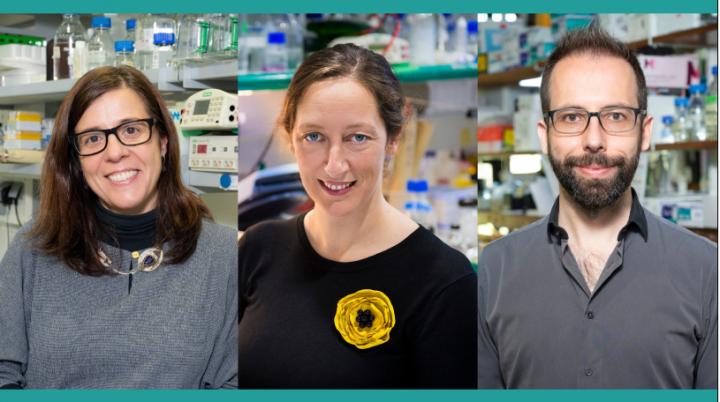European Research Council (ERC) released the 2020 list of projects distinguished with the competitive Consolidator Grants. Maria João Amorim, Raquel Oliveira and Ricardo Henriques are the three researchers from Instituto Gulbenkian de Ciência

Credit: ©IGC 2020
Since the establishment of the European Research Council in 2008, the IGC has secured 17 of their competitive grants (7 Starting, 8 Consolidator and 2 Advanced). During the year of 2020, the Institute had seven active ERCs. In 2021, with the start of the new grants awarded this month, it will have ten active grants.
The year of 2020 marks a total of 327 researchers selected for the attribution of ERC Consolidator Grants out of more than 2000 submitted proposals over the years. This funding consolidates the scientific careers of the awardees and allows them to find answers to great questions, in different research centres all over Europe. Women set the record of 37% of the awarded grants, the highest number ever. The projects are distributed across 23 different countries and were awarded to scientists of 39 different nationalities.
Oriented by the curiosity of the researcher, the ERC approach allows scientists to identify new opportunities and directions in any field, instead of being led by politically defined priorities. This is the great impact and differentiating factor of this approach, which guarantees that the funds are channelled to new and promising areas with a great degree of flexibility.
According to Jean-Pierre Bourguignon, President of the ERC, “this funding not only empowers brilliant minds all over Europe to pursue their most ambitious ideas in a critical moment of their careers, but also helps to train the younger generation of researchers that is part of their teams. To prepare for the challenges of tomorrow, Europe must maintain the vision of investing in fundamental science, which has shown repeatedly its crucial added value. That is why so many count on European leaders to provide the pillar of “Excellent Science” of Horizon Europe with the essential resources to strengthen Europe as a whole”.
Selected Projects at Instituto Gulbenkian de Ciência:
LOFlu – 2.87M€
Vaccine development or antibody treatments are not necessarily the best way to fight predictable infections in humans caused by new emerging viruses, like the influenza, corona or Ebola. Other approaches need to be identified, namely the development of specific therapies against the virus. Focusing on the virus influenza A, the research project led by Maria João Amorim – LOFlu – aims at paving the way for new antiviral strategies that, as we all know and experience nowadays, are so important to fight epidemics and pandemics. The project intends to study the way viruses exploit the organisms they infect and discover the “Achilles heels” of their life cycles. The research team led by Maria João Amorim was the first to propose, in a previous study, that the assembly of the genome of the flu virus occurs in specific places or “assembly factories” produced in infected cells following the instructions coded by the virus. The team discovered that these places have liquid properties, proposing that the mechanism by which they form is similar to the phase separation that happens when you mix oil and vinegar, for instance. Now, Maria João Amorim and her team, “define a new approach to study viral infections that explores the concepts behind phase separation to better understand the “Achilles heels” of the virus, namely through the identification of factors and cellular processes of the host that the virus uses and shapes, and this way try to uncover methodologies to control viral infections”, explains the researcher. The results of this study might provide new therapies applicable to this infection as well as other infections that rely on the same processes. They might also contribute to explain other aspects of biomedicine, like research on neurodegenerative diseases and some kinds of cancer. To Maria João, receiving this grant “at the time of the critical situation of the pandemic we are facing, is an enormous responsibility given the urgency of the question. With this funding we will be able to guarantee a better preparation of a future response in the fight against viral infections. Supporting this approach is essential and prestigious”, she concludes.
Maria João Amorim graduated in Biochemistry at the University of Porto and obtained her PhD in Virology at the University of Cambridge, followed by post-doctoral work at the National Institute for Medical Research and at the University of Cambridge, in the UK. She is the leader of the Celular Biology and Viral Infections group at Instituto Gulbenkian de Ciência since 2012. More information about the research group
ChromoSilence – 2M€
Access to the genetic information encoded in the chromosomes is the basis of life. However, there is a period in the life of a cell in which the constant reading of this information is suddenly halted. That happens every time cells enter mitosis (division process that occurs in most of the cells in our body), when the large part of the transcription of the genetic information is shut off. How such silencing occurs remains yet to be clarified, together with the true purpose of the abrupt interruption in the transcription activity. Raquel Oliveira, awarded with an ERC starting Grant in 2014, secures again funding for her research in chromosomes, revealing the importance of her work to the knowledge in the field. ChromoSilence, the project she will lead, uses a new approach to unravel how the process of transcription silencing during cell mitosis is established and regulated. The researcher aims at discovering how failure in the silencing of chromosomes during mitosis affects the fidelity of chromosome segregation and organismal development. According to Raquel Oliveira “it is very gratifying to see, once again, my research awarded with this important funding. The knowledge we produce will contribute to understanding how these two processes essential to life – cell division and transcription of genetic information – relate between themselves and eventually discover new mechanisms that ensure genomic stability or the control of gene expression”.
Raquel Oliveira graduated in Biochemistry at the University of Porto and obtained her PhD in Biology and Experimental Biomedicine at the University of Coimbra. She developed her work at Instituto de Biologia Molecular e Celular, at the University of Porto, in Portugal, as well as at the University of Bayreuth and the University of Oxford. She arrived at Instituto Gulbenkian de Ciência in 2012 to establish her research group Chromosome Dynamics. More information about the research group
SelfDriving4DSR (Enabling Live-Cell 4D Super-Resolution Microscopy Guided by Artificial Intelligence)- 2M€
With the recently funded project, Ricardo Henriques will develop a new type of self-driving microscope controlled by artificial intelligence. This technology will be able to follow the behaviour of cells infected by viruses in spatial and temporal scales until now impossible. The creation of new technologies based on artificial intelligence, optics and cell biology will allow a new understanding of cellular behaviour and viral infection. The project led by Ricardo will focus particularly on the infection by HIV-1. To Ricardo Henriques, “the ERC project will stimulate the development of new technologies allowing new observations of cell behaviour at the scale of the nanometres. This multidisciplinary project combines a new generation of concepts from optical physics, artificial intelligence and cell and infection biology. Not only it can be the key to understanding biological systems, but also to fighting infectious diseases like the one causing the current pandemic we are living in. At Instituto Gulbenkian de Ciência and in Portugal, it will allow us to form a new generation of researchers capable of crossing the limits of our knowledge in medicine, able to perform biological studies with unprecedented technology”.
Ricardo Henriques graduated in Particle Physics and fell in love early on with Biology. He obtained his PhD while working in the laboratories led by Musa Mhlanga and Christophe Zimmer, simultaneously developed Portugal (iMM), France (Institut Pasteur), South Africa (CSIR), UK and USA ((Andor Technology). It was during this path that he started working in the field of super-resolution microscopy and developed technologies capable of reading images of cells and viral structures. In 2013 he established his first research group at University College London (UCL), in 2017 accepts the invitation to set up a second laboratory at the Francis Crick Institute and in 2019 becomes a professor UCL. He arrived at Instituto Gulbenkian de Ciência in September 2020 to lead a new research group that will develop new technologies to allow us to see the invisible, like the biology of viral infection. More information about the research group
###
Media Contact
Ana Morais
[email protected]
Original Source
https:/




